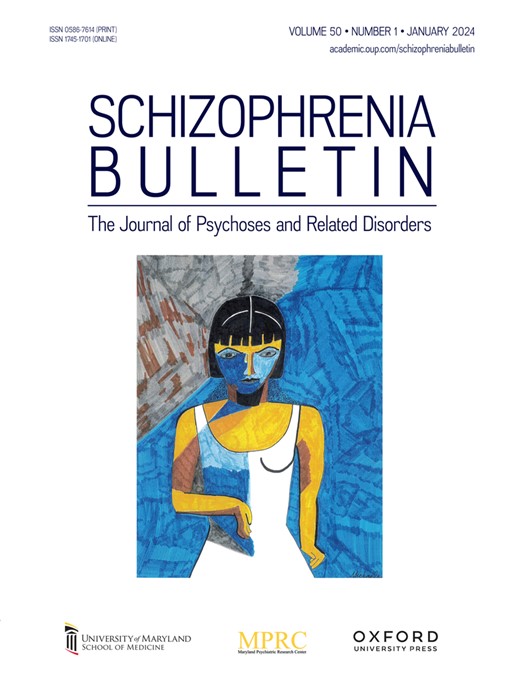注视任务:一个简单的眼动任务揭示了精神分裂症的损害
IF 4.8
1区 医学
Q1 PSYCHIATRY
引用次数: 0
摘要
背景注视稳定性(FS)是视觉运动处理的一个基本基础,它可以通过在一个简单的、易于执行的注视视觉刺激的任务中跟踪眼球运动来评估。我们研究了有和没有干扰物的FS作为antipsychotic-naïve/free精神分裂症(SCZ)、SCZ一级亲属(FDRs)和健康对照(HC)的内表型标志物的潜力。方法记录69个antipsychotic-naïve/free SCZ、49个fdr和76个HCs在注视稳定性任务中的单目高频眼动追踪数据。这项任务需要保持对中心圆形目标的凝视,同时忽略相同的外围干扰物,当存在时,在两侧的近/远距离。采用ANCOVA和RMANCOVA分析各组的固定稳定性以及牵张器效应的偏侧性和距离的影响。结果SCZ组的注视频率、扫视幅度和扫描路径长度显著高于其他组(ηp2 = 0.05 ~ 0.07)。引入干扰物导致SCZ成绩进一步恶化(ηp2 = 0.09-0.23)。一级亲属中位固定时间出现损伤(ηp2 = 0.13)。在两组间干扰物较远的试验中,观察到更高的眼跳振幅和扫描路径长度(ηp2 = 0.09)。横向*组对扫描路径长度有显著的交互作用(ηp2 = 0.03)。讨论在抗精神病naïve/自由SCZ中注意到FS损害,并且随着引入分心物而恶化。在SCZ及其fdr中发现了一种反向偏侧效应(右偏),表明视觉功能不对称性的衰减/逆转可能与SCZ易感性有关。未来的研究应该评估FS作为不同临床阶段的疾病标志。本文章由计算机程序翻译,如有差异,请以英文原文为准。
Fixation Task: A Simple Eye Movement Task Reveals an Impairment in Schizophrenia
Background Fixation stability (FS) is a basic substrate of visuomotor processing that can be assessed by tracking eye movements during a simple, easy-to-perform task of gazing at a visual stimulus. We studied FS with and without distractors for its potential as an endophenotype marker in antipsychotic-naïve/free schizophrenia (SCZ), SCZ first-degree relatives (FDRs), and healthy controls (HC). Method Monocular high-frequency eye tracking data were recorded during a fixation stability task in 69 antipsychotic-naïve/free SCZ, 49 FDRs, and 76 HCs. The task required maintenance of gaze on a central circular target while ignoring an identical peripheral distractor, when present, at near/farther distances on either side. Fixation stability across the groups and the effect of laterality and distance of the distractor effect were analyzed using ANCOVA and RMANCOVA. Result SCZ had significantly higher fixation frequency, saccade amplitude, and scanpath length compared to the other groups, even in trials without distractors (ηp2 = 0.05–0.07). Introducing distractors resulted in further worsening of performance in SCZ (ηp2 = 0.09–0.23). First-degree relatives showed impairment in median fixation duration (ηp2 = 0.13). Higher saccade amplitudes and scanpath lengths (both ηp2 = 0.09) were noted in trials with farther distractors across the groups. A significant interaction effect of the laterality * group was noted on scanpath length (ηp2 = 0.03). Discussion FS impairment was noted in antipsychotic naïve/free SCZ, and it worsened with the introduction of distractors. An inversed laterality effect (rightward-bias) of distractor was noted in SCZ and their FDRs, suggesting a possible association of attenuation/reversal of visual functional asymmetry with SCZ vulnerability. Future studies should evaluate FS as illness markers across different clinical stages.
求助全文
通过发布文献求助,成功后即可免费获取论文全文。
去求助
来源期刊

Schizophrenia Bulletin
医学-精神病学
CiteScore
11.40
自引率
6.10%
发文量
163
审稿时长
4-8 weeks
期刊介绍:
Schizophrenia Bulletin seeks to review recent developments and empirically based hypotheses regarding the etiology and treatment of schizophrenia. We view the field as broad and deep, and will publish new knowledge ranging from the molecular basis to social and cultural factors. We will give new emphasis to translational reports which simultaneously highlight basic neurobiological mechanisms and clinical manifestations. Some of the Bulletin content is invited as special features or manuscripts organized as a theme by special guest editors. Most pages of the Bulletin are devoted to unsolicited manuscripts of high quality that report original data or where we can provide a special venue for a major study or workshop report. Supplement issues are sometimes provided for manuscripts reporting from a recent conference.
 求助内容:
求助内容: 应助结果提醒方式:
应助结果提醒方式:


